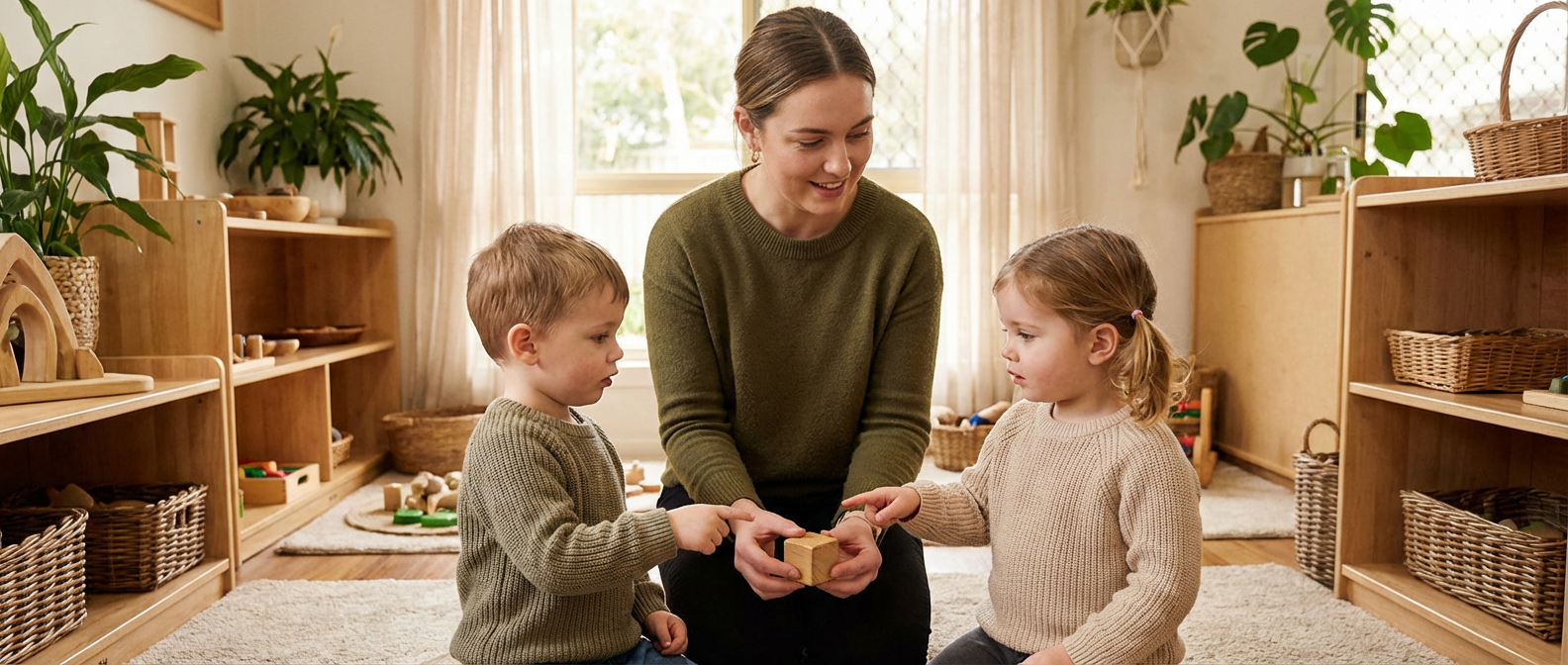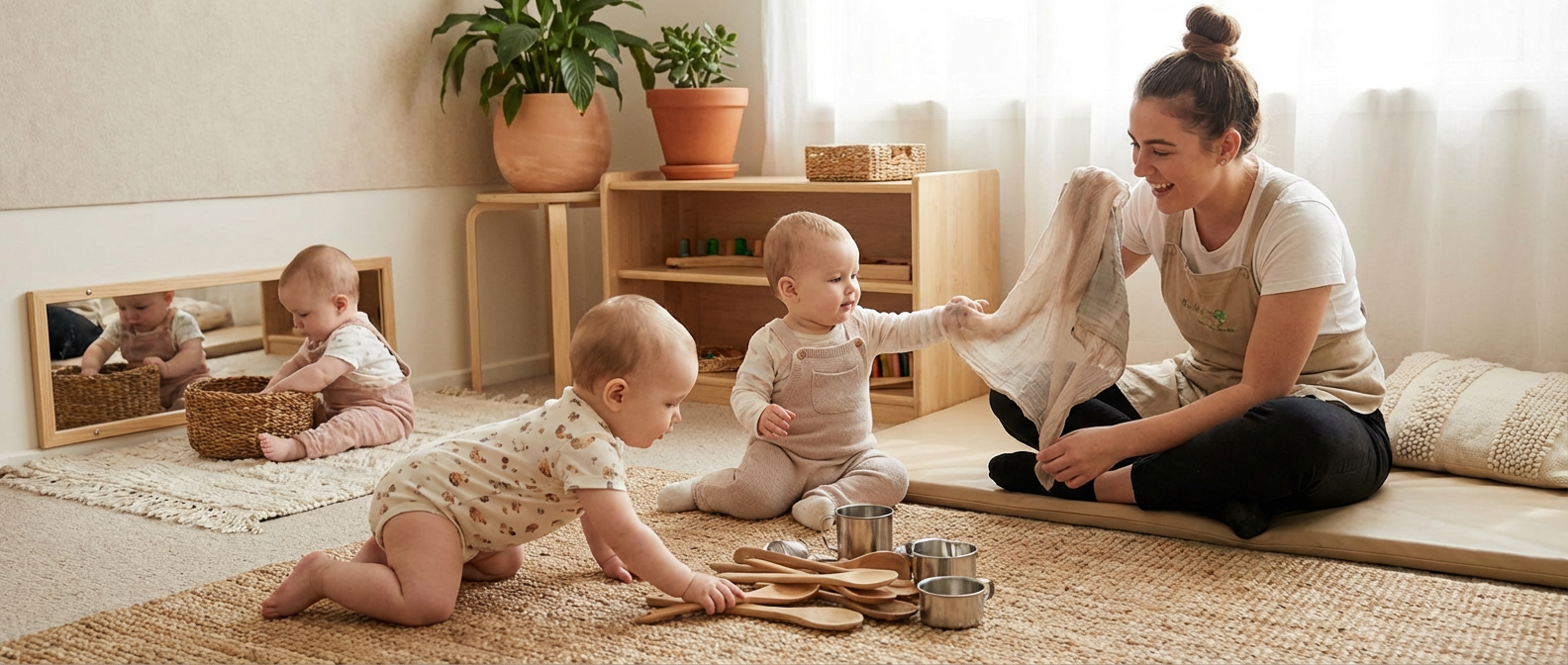Play is often described as the “work” of childhood and we know this is for good reason. Through play, children learn to communicate, problem-solve, imagine, and cooperate. It’s how they practice real-world skills in a safe and fun way. In early childhood education, understanding the different forms of play helps educators create environments that meet children where they are and gently guide them toward new skills.
While play looks spontaneous on the surface, there is rich developmental growth happening underneath. From an infant’s first attempts to explore their surroundings with movement to preschoolers building elaborate pretend worlds together, each form of play has a purpose. As educators, the more we understand these forms, the better we can support children in building strong foundations for learning and life.
Why Play Matters
Play is not a break from learning, it is learning. Through playful exploration, children strengthen cognitive skills like memory and reasoning, develop social and emotional awareness, and grow physically through both fine and gross motor activity. Play also supports resilience: it allows children to test out new ideas, face challenges, and express emotions safely.
Educators who intentionally observe and nurture play give children the best chance to thrive. By knowing the forms of play, teachers can design environments and interactions that support each child’s developmental journey.
The Forms of Play
Developmental psychologist Mildred Parten first described six classic forms of play in the 1930s. Modern research has expanded on her work, but her framework remains central to how educators understand social play development. Children don’t move through these forms in a strictly linear way; they may shift back and forth depending on age, confidence, and context, however each stage is significantly important in a child's development and growth.
1. Unoccupied Play
This is the earliest form of play, often seen in infants. Babies may kick their legs, wave their arms, or watch movements around them. To an adult, it may not look like “play,” but it is the foundation of learning, children are discovering their own bodies and how they connect to the world. In the classroom this may look like a six-month-old lying on a soft mat, swatting at a dangling rattle. Each movement is random at first, but over time the baby learns cause and effect: “When I move, the toy shakes.”
Tip: Provide safe, sensory-rich environments like mats, rattles, textured fabrics, and gentle music. Narrate what you see: “You kicked your legs and made the rattle shake!”
2. Solitary Play
Toddlers often prefer to play alone, focusing on their own activity without engaging with peers. Solitary play helps children build concentration, independence, and creativity. In a classroom this may look like a two-year-old stacking blocks in a tower, fully absorbed, while other children play nearby.
Tip: Respect solitary play! It’s an important step toward independence. Offer open-ended materials like blocks, books, or puzzles that encourage exploration without pressure to interact.
3. Onlooker Play
In this stage, children begin to watch others play without joining in. They may observe closely, make comments, or imitate later. Onlooker play shows curiosity about peers and is a stepping stone to social play. In the classroom this may look like a child sitting near the sand table, watching peers build castles. They don’t touch the sand but they talk about what they see: “That’s a big castle!”
Tip: Acknowledge their role. Say, “You’re watching how your friends scoop and pour. Would you like to try?” Respect their choice if they’re not ready to join.
4. Parallel Play
Children play side by side but not directly with each other. They may use the same materials and mirror actions but without shared goals. Parallel play helps children feel comfortable in group settings and lays the groundwork for cooperation. In the classroom this may look like two toddlers sitting at the art table, each painting on separate papers. They glance at each other, occasionally copying colors or strokes, but remain focused on their own creations.
Tip: Ensure that duplicates of any material possible are available to help reduce friction or conflicts in the classrooms. Narrate what you see: “You’re both painting with blue. You noticed your friend’s picture.”
5. Associative Play
Here, children begin to interact, sharing materials or commenting on each other’s play, but still without fully coordinating. They are interested in what others are doing and begin practicing communication and negotiation. This may appear in the classroom as a group of preschoolers building with blocks. One says, “I’m making a house,” and another adds, “I’m making a garage.” They talk about their structures but are not working on the same project.
Tip: Encourage dialogue. Ask open-ended questions: “What are you building together?” This scaffolds cooperation without forcing it.
6. Cooperative Play
By preschool and kindergarten, many children engage in cooperative play, working together toward a shared goal. This requires advanced skills: planning, negotiating, empathy, and problem-solving. In the classroom this may appear as four children playing “restaurant.” They assign roles (chef, server, customer), set rules, and act out scenarios. Disagreements arise: “You can’t be the chef again!” but they negotiate and continue.
Tip: Support with gentle guidance. Model phrases like “How can we solve this problem?” or “Can you take turns?” to help children practice conflict resolution.
Forms of Play and Their Benefits
|
Form of Play
|
Typical Age Range
|
What it Looks Like
|
Developmental Benefits
|
|
Unoccupied
|
Infancy
|
Random movements, gazing, exploring body
|
Sensory awareness, motor skills
|
|
Solitary
|
1–2 years
|
Playing alone, focused on own task
|
Independence, concentration
|
|
Onlooker
|
2–3 years
|
Watching others, imitating later
|
Observation, language growth
|
|
Parallel
|
2–3 years
|
Playing side by side without interaction
|
Comfort in groups, social awareness
|
|
Associative
|
3–4 years
|
Sharing materials, some interaction
|
Communication, negotiation
|
|
Cooperative
|
4–6 years
|
Shared goals, role play, teamwork
|
Collaboration, empathy, problem-solving
|
Common Pitfalls When Supporting Play
Even experienced educators can sometimes unintentionally hinder play. Here are some common pitfalls and how to avoid them.
-
Over-directing play: Adults sometimes step in too quickly, turning play into instruction. Solution: try to always observe first, guide gently if needed.
-
Rushing social stages: Expecting toddlers to “share” before they’re developmentally ready leads to frustration.
Solution: allow parallel play to unfold naturally and ensure an adequate number of resources per child are available in the room for the children.
-
Undervaluing solitary or onlooker play: These are often dismissed as “less social,” but they are essential steps.
Solution: provide space and reassurance for all forms.
-
Not providing enough open-ended materials: Too many fixed-use toys limit imagination.
Solution: offer blocks, fabric, art supplies, open-ended toys and natural objects for the children.
-
Forgetting to document play: Without recording, valuable insights are lost.
Solution: use quick notes, photos, or apps to capture learning in the moment. Parent App’s voice-to-text feature allows you to make notes on the go, while its autodraft save feature lets you get back to the notes or observations when you have time and without losing your train of thought.
How Families Can Support Play at Home
Educators can extend the value of play by guiding families to encourage it at home. Suggestions include:
-
Provide time and space: Unstructured playtime allows creativity to flourish.
-
Follow the child’s lead: Let children choose the game or story.
-
Value all play forms: Whether a child is playing alone or acting out an elaborate scene, each has purpose.
-
Join in sometimes: Children love when adults enter their play world, but let the child lead.
-
Connect with school play: Ask children about games they play with peers and mirror them at home.
How Technology Supports Educators
Documenting play is crucial for curriculum planning and family communication but it can feel overwhelming. This is where tools like Parent App make a difference. Educators can:
-
Record notes, photos, or short videos of play in real time.
-
Tag observations to developmental frameworks (like EYFS).
-
Build a child’s learning journey without extra paperwork.
-
Share updates instantly with families, helping them understand the value of play.
This not only streamlines the workload but also deepens the partnership between educators and families.
Play is Learning
Play is not a distraction from learning, it is the foundation of learning. Each form of play, from solitary exploration to cooperative teamwork, teaches children essential skills for life. By understanding and supporting these forms, educators honor the natural ways children grow and thrive.
When we step back and observe with intention, we see the richness of play: the quiet determination of a toddler stacking blocks, the curiosity of a child watching peers, the collaboration of preschoolers inventing worlds together. These moments are more than games, they are the heartbeat of early childhood education.
Interested in seeing how Parent can support you and your centre?
Let’s talk. Book a quick, no obligation, walkthrough with our team
If you found this post helpful, explore our free webinars, activity library, and newsletter for more support in your early years journey.
Billing, Invoicing Automation & Smart Finances
Communication & Engagement
Child Development & Progress
Waitlist, Forms & Attendance
Effortless Team Management
Daily Updates That Matter
Templates & Printables
Blogs
Webinars
Case Studies & Testimonials
FAQs
Help Center


.png)

